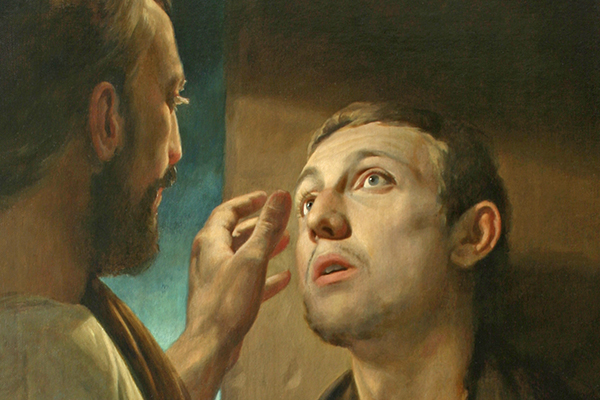Written by Mary Rearick Paul
From her column Dwelling with God

When I was in second grade and put on a pair of prescription glasses for the very first time, I was amazed (and more than a little ticked) that everyone else had always been able to see the world with such clarity. As I was reading through the Gospel of Mark recently, I realized how often Jesus serves as an optometrist, providing His followers, and us, a new vision of the kingdom of God, frequently adjusting our spiritual lenses as we grow and journey with Him: How does that look now? Tell me what you see?
The eighth chapter relates this remarkable healing story:
22Jesus and his disciples came to Bethsaida. Some people brought a blind man to Jesus and begged him to touch and heal him. 23Taking the blind man’s hand, Jesus led him out of the village. After spitting on his eyes and laying his hands on the man, he asked him, “Do you see anything?” 24The man looked up and said, “I see people. They look like trees, only they are walking around.” 25Then Jesus placed his hands on the man’s eyes again. He looked with his eyes wide open, his sight was restored, and he could see everything clearly. 26Then Jesus sent him home, saying, “Don’t go into the village!”[1]
This theme of clarity of vision is brought out earlier for us in verse 18: “Do you have eyes but fail to see?”[2]And so here in this odd two-step healing (the only time Jesus needs to repeat a healing to get it right) the disciples (and we) are invited to see that this repeated restoration is not just for the man of Bethsaida but also for the disciples, and for us, as well. Mark has these moments that are akin to when a character on film or television breaks the so-called fourth wall and speaks directly to the audience. Here, Jesus seems to turn His face toward you and me to ask: “Do you see anything?[3]
We are presented with the Jesus who brings healing and grace upon grace for all people out to the edges of the community. This includes those who are considered untouchables, outcasts, so dangerous the community has sent them away to live in a cemetery. This new kingdom is not about our joining Jesus in some sort of top-down power system, it is about a new kind of community. As we journey through the Gospels, we are introduced to our sisters and brothers, some of whom we may like; others we may not. We may resist these introductions when, like the disciples, we tend to encourage Jesus to pay more attention to the powerful and ignore those on the edges. All of us are living lives that are being transformed in response to a Jesus who says, “to be the greatest is to serve,” “to be the Messiah means sacrificial love.” We cannot save our lives by preserving them nor lose them by giving them up.
Jesus comes with a message which is good news for all. The challenge is to accept not just the good news that affirms, but also the part that disrupts. Are we ready for the two-step healing? The focus is not that there are two steps, but there is more of Jesus and His kingdom come that we are invited to receive. This “more” of Jesus is a calling that takes patience and humility, and gives an irrepressible hope.
Jesus is committed to patiently walking with the disciples, speaking and embodying the good news, pausing enough to ask them: “Do you understand.” He doesn’t expect it all to happen at once. He is aware that this life with God is a commitment to having the “yeast of the Pharisees and that of Herod…replaced by the yeast of God”.[4] Humility is needed as we recognize that vision adjustments are needed throughout our lives. As Paul says, we all do indeed only “know partially, but then I [we] will know completely…”[5] In other words, our ability to see Jesus and His “kingdom come” needs ongoing healing.
The healing of sight occurs when the man looks for a second time with his eyes wide open. God’s kingdom is discovered on the way.
There is something about the ongoing movement and realization of God’s “kingdom come” that we are invited to know as we join in this journey with Jesus with eyes wide open. In all of this I breathe deep—trusting that Jesus will continue to correct my vision that I might receive and believe that there is more new life and new sight to be found.
Mary Rearick Paul, D.Min., is vice president of spiritual development at Point Loma Nazarene University.
[1] Mark 8: 22-26 (CEB)
[2] Mark 8: 17b
[3] Mark 8: 23b
[4] Mark 8:15
[5] I Corinthians 13:12b
